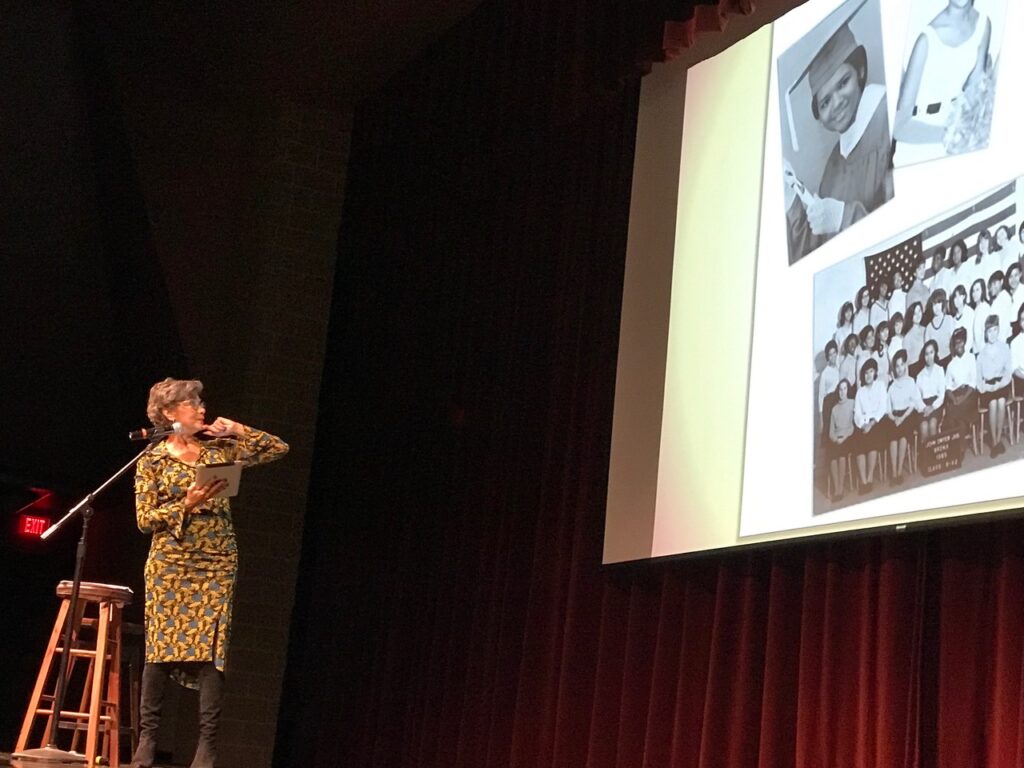By DAVID DUPONT
BG Independent News
Kimberley Fisher came dressed for the occasion.
She was one of more than 200 people who attended on Thursday the Wood County Library Foundation Series’ talk by Sonia Manzano, an author, screenwriter, actress, and mostly famously Maria for 44 years on “Sesame Street.”
Fisher, dressed in a Sesame Street-themed skirt she told Manzano that it was “so awesome to see adults with children, interacting with them, and they wanted to be in that space.” Those interactions were full of “energy and joy and love.”
“Thank you for making it comfortable for adults to be around adults,” she said. “I just wanted to thank you for that.”
Now a children’s librarian at Toledo-Lucas County Library she wears her Sesame Street skirt for story times.

Manzano said that it’s important to humanize parents, showing them as people who may lose an earring or forget to bring the Tootsie Rolls.
When “Sesame Street” made its debut in 1969 it changed not just television but education, Manzano said. “People began to see children in a new light. … Children picked up information quicker than we could have ever imagined.”
Though the show was aimed at preschoolers aged 4 and 5, she said, “we were stunned that 3-year-olds were picking up the same information, and then 2-year-olds.”
Back in the 1960s, children started school later, and didn’t learn the alphabet until they were 6 or 7.
“It was so groundbreaking that teachers had to change their curriculum because kids started school knowing all this information,” she said.
And Manzano, who joined the show in 1971, could relate.
“ I remember as a kid being thirsty for knowledge before I started kindergarten.”
“Sesame Street” emerged in a time of turbulence and reflected that. The goal was to use television to give underprivileged kids the kind of background that their more privileged peers had. The cast was multi-racial, and multi-cultural.
Manzano, the child of parents born in Puerto Rico said she loved television as a child, but she never saw people who looked like her. “Blacks and Hispanics were invisible,” she said. “I was raised in a neighborhood in the South Bronx, and I watched a lot of television growing up, and I always loved television, but not seeing anybody who looked like me, or lived in a neighborhood like I did, not seeing myself reflected in the general society made me wonder how I was contribute or what I what I could contribute to a society that didn’t see me.”
She credited the social activists, Young Lords, with instilling in her a sense of pride in her Puerto Rican heritage and self-confidence.
That allowed her to portray a strong, confident Maria on Sesame Street among all the Muppets. She recalled during the question-and-answer session that the puppeteers would try to throw her off. Early on she was so nervous she kept looking at the puppeteer. Frank Oz, in the Grover’s voice, chastised her: “Quit looking at that man down there.”
“Well, that cured me,” she said.
Manzano said she felt she lived a double life. But her lives on and off “Sesame Street” echoed each other. She was courted, married, and gave birth on “Sesame Street” and in real life. She quipped that they were the first reality show, adding “without the whining.”
Many people thought she and Emilio Delgado, who played her husband Luis on the show, were married in real life. Once when traveling together, a woman approached them and gushed how it was wonderful that her children could see “real love” on the show, and that they were willing to share their lives with their young viewers.
Manzano said they told her: “We’re not really married.”
The fan was taken aback, then said: “As long as you really love each other.”
Manzano also wrote for the show including the episodes dealing with her marriage and the birth of her daughter, played by her real-life daughter Gabriela.
The show also dealt with death when the actor who portrayed the grocer Mr. Hooper, Will Lee, died.
Some advised them not to confront the death, just to send the character on a trip or have him retire.
Instead, they did the show recording it in one take.
She recalled listening to performer and Civil Rights activist Lena Horne singing “It’s Not Easy Being Green” with Kermit the Frog. “Are they really singing about what I think they’re singing about?” she wondered. Yes, the song could be about race, or about being a frog. Children would absorb what they can.

Following her retirement in 2015 from the show, she continued her work as a writer, both for children, and more recently for young adults. She’s also written a memoir, “Becoming Maria,” that deals frankly with her upbringing in the South Bronx. “I grew up in a household ruled by domestic violence.”
She said that “children find a way to comfort themselves. My way was television.”
She also has a long list of acting credits beginning with being in the original Off-Broadway production of “Godspell” and continuing through appearances on TV and movies.
In 2021, Manzano returned to her South Bronx neighborhood, when she created “Alma’s Way.”
The title character is a 6-year-old Puerto Rican girl who carefully thinks her way through the challenges that life presents her.
“I hope the viewers see the process of thinking and that everyone can think,” Manzano said. “We certainly do need that in our country now, the ability to think critically and separate one idea from another. It’s an art we’re losing too quickly.”





